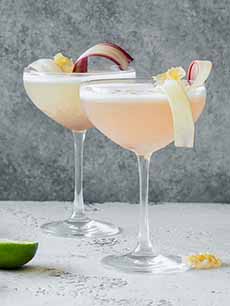TIP OF THE DAY: Pisco From Peru
|
July 26th is National Pisco Day—a day to drink Pisco, and to try Brazil’s national cocktail, the Pisco Sour (recipe below). We’re about to introduce you to Pisco. Below you’ll find: Here are some of our favorite foods originated in Peru, all cultivated by the Incas: At the end of each of the past four years, food trend analysts have predicted that Peruvian food will be the next hot cuisine in the U.S. But it hasn’t happened yet. Although it’s on numerous menus, most people don’t realize that ceviche originated in Peru. Peru’s national cocktail, the Pisco Sour, remains the best-known Peruvian food in the U.S. For a Peruvian feast, try some of these popular Peruvian dishes (you can find many recipes online): Back to Pisco: The spirit was developed by Spanish settlers in the 16th century as an alternative to orujo, a pomace brandy that was imported from Spain. Not only did they have to wait for the cargo ship to show up; but pomace is not hard to come by. It’s distilled from what’s after from pressing wine grapes (what’s left are the grape skins and seeds). In Europe, estate owners typically gave this residue from their grapes to their farm workers, to distill for their own consumption. The end product, depending on the country, is brandy, grappa, pisco and other firewater*. In the late 1550s, the Spanish settlers began to plant quality wine grapes. Peruvian farmers did the same as their European counterparts: They distilled a clear liquid from the pressed wine residue given to them. Pisco was discovered by sailors in the 18th century, when it became part of the growing Peruvian export trade. It was easier to transport Pisco up the West Coast from Peru than to transport whiskey overland from the East Coast. Thus, Pisco made its way to San Francisco, where it was enjoyed during the Gold Rush (1848–1855) through 1920, when Prohibition put the cap on alcohol. Today there are many Pisco brands available in the U.S., including what has to be our favorite name, Macchu Pisco (get it)? Today, premium brands are distilled from the wine itself, not from the residue. The category’s ulta-premium brand is Pisco Portón, an elegant distillate with fruit aromas and flavors; we enjoyed drinking it neat. Peru’s national cocktail (photos #1, #2, #3) is also a favorite in the U.S. Ingredients For One Drink 1. Combine first four ingredients in a shaker with ice and shake. 2. Strain into a chilled glass. Add a dash of bitters. |
|
|
|
________________ *Firewater is actually a generic term for alcoholic beverages that contain between 30% and 60% alcohol by volume—that’s 60 to 120 prove. The Spanish word is aguardiente, which means “fiery water” or “burning water.” Brandy originates from brandywine, the Dutch word for “burnt wine.” The spirit is named from Pisco, a town located on the coast of Peru. Often, products were named for the town from which they were shipped.
|
||







